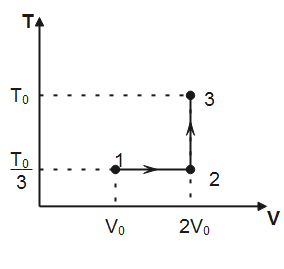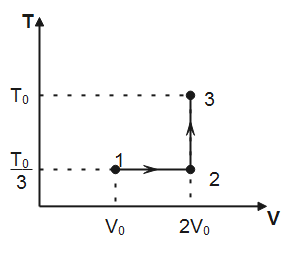
Answer
425.1k+ views
Hint: First analyze the type of process from the TV-diagram given. Then, calculate the work done, change in internal energy during each process and for the process $1\to 2\to 3$ as well. First law of thermodynamics can be used to determine the heat transferred during any process.
Formula used: In an isothermal process, $W=nRT\ln \dfrac{{{V}_{f}}}{{{V}_{i}}}$
In an isochoric process, $\Delta U=\dfrac{f}{2}nR\Delta T$
First law of thermodynamics, $Q=\Delta U+W$
Complete step by step answer:
Note that, in process $1\to 2$ temperature is constant hence, the process is isothermal. In process $2\to 3$, volume of the gas remains conserved, therefore, the process $2\to 3$ is isochoric. Degree of freedom for a monatomic gas, $f=3$

(I) Work done for isothermal process $1\to 2$ is given by
${{W}_{1\to 2}}=nRT\ln \dfrac{{{V}_{f}}}{{{V}_{i}}}$
Where $n$ is the number of moles of the gas, $T$ is the absolute temperature and ${{V}_{f}}\And \,\,{{V}_{i}}$ denotes final and initial volume of the gas respectively. Substituting the values observed from plot, we have
${{W}_{1\to 2}}=1\times R\times \dfrac{{{T}_{0}}}{3}\ln \dfrac{2{{V}_{0}}}{{{V}_{0}}}=\dfrac{R{{T}_{0}}}{3}\ln 2$
Work done for the isochoric process $2\to 3$ is zero. Since, no volume is changed during an isochoric process, the work done (which is linearly proportional to change in volume) is zero.
${{W}_{2\to 3}}=0$
Therefore, work done by the system in process $1\to 2\to 3$ is
${{W}_{1\to 2\to 3}}={{W}_{1\to 2}}+{{W}_{2\to 3}}=\dfrac{R{{T}_{0}}}{3}\ln 2+0=\dfrac{R{{T}_{0}}}{3}\ln 2$
This implies that $I\to P$
(II) Internal energy changed in process $1\to 2\to 3$ is given by
$\Delta {{U}_{1\to 2\to 3}}=\Delta {{U}_{1\to 2}}+\Delta {{U}_{2\to 3}}$
This implies that,
$\Delta {{U}_{1\to 2\to 3}}=\dfrac{f}{2}nR\Delta {{T}_{1\to 2}}+\dfrac{f}{2}nR\Delta {{T}_{2\to 3}}$
Substituting the values observed from the plot, we have
$\Delta {{U}_{1\to 2\to 3}}=\dfrac{f}{2}\times 1\times R\left( \dfrac{{{T}_{0}}}{3}-\dfrac{{{T}_{0}}}{3} \right)+\dfrac{f}{2}\times 1\times R\left( {{T}_{0}}-\dfrac{{{T}_{0}}}{3} \right)=\dfrac{3}{2}R\times \dfrac{2{{T}_{0}}}{3}$
Solving the above equation, we obtain
$\Delta {{U}_{1\to 2\to 3}}=R{{T}_{0}}$
This implies that $II\to R$
(III) According to the first law of thermodynamics, heat transferred in a thermodynamic process is the sum of change in internal energy of the system and work done by the system. That is,
${{Q}_{1\to 2\to 3}}=\Delta {{U}_{1\to 2\to 3}}+{{W}_{1\to 2\to 3}}$
Substituting the values, we obtained above, we have
${{Q}_{1\to 2\to 3}}=R{{T}_{0}}+\dfrac{R{{T}_{0}}}{3}\ln 2$
${{Q}_{1\to 2\to 3}}=\dfrac{R{{T}_{0}}}{3}\left( 3+\ln 2 \right)$
This implies that $III\to T$
(IV) Similarly, for process $1\to 2$
${{Q}_{1\to 2}}=\Delta {{U}_{1\to 2}}+{{W}_{1\to 2}}$
Substituting the values, we get
${{Q}_{1\to 2}}=0+\dfrac{R{{T}_{0}}}{3}\ln 2=\dfrac{R{{T}_{0}}}{3}\ln 2$
This implies that $IV\to P$
Hence, option D is correct.
Note: In TV-diagram, line parallel to horizontal axis shows an isothermal process and line parallel to vertical axis shows an isochoric process. The work done in an isochoric process is zero.
According to the first law of thermodynamics, heat transferred in a thermodynamic process is the sum of change in internal energy of the system and work done by the system. This law is based on conservation of energy.
Formula used: In an isothermal process, $W=nRT\ln \dfrac{{{V}_{f}}}{{{V}_{i}}}$
In an isochoric process, $\Delta U=\dfrac{f}{2}nR\Delta T$
First law of thermodynamics, $Q=\Delta U+W$
Complete step by step answer:
Note that, in process $1\to 2$ temperature is constant hence, the process is isothermal. In process $2\to 3$, volume of the gas remains conserved, therefore, the process $2\to 3$ is isochoric. Degree of freedom for a monatomic gas, $f=3$

(I) Work done for isothermal process $1\to 2$ is given by
${{W}_{1\to 2}}=nRT\ln \dfrac{{{V}_{f}}}{{{V}_{i}}}$
Where $n$ is the number of moles of the gas, $T$ is the absolute temperature and ${{V}_{f}}\And \,\,{{V}_{i}}$ denotes final and initial volume of the gas respectively. Substituting the values observed from plot, we have
${{W}_{1\to 2}}=1\times R\times \dfrac{{{T}_{0}}}{3}\ln \dfrac{2{{V}_{0}}}{{{V}_{0}}}=\dfrac{R{{T}_{0}}}{3}\ln 2$
Work done for the isochoric process $2\to 3$ is zero. Since, no volume is changed during an isochoric process, the work done (which is linearly proportional to change in volume) is zero.
${{W}_{2\to 3}}=0$
Therefore, work done by the system in process $1\to 2\to 3$ is
${{W}_{1\to 2\to 3}}={{W}_{1\to 2}}+{{W}_{2\to 3}}=\dfrac{R{{T}_{0}}}{3}\ln 2+0=\dfrac{R{{T}_{0}}}{3}\ln 2$
This implies that $I\to P$
(II) Internal energy changed in process $1\to 2\to 3$ is given by
$\Delta {{U}_{1\to 2\to 3}}=\Delta {{U}_{1\to 2}}+\Delta {{U}_{2\to 3}}$
This implies that,
$\Delta {{U}_{1\to 2\to 3}}=\dfrac{f}{2}nR\Delta {{T}_{1\to 2}}+\dfrac{f}{2}nR\Delta {{T}_{2\to 3}}$
Substituting the values observed from the plot, we have
$\Delta {{U}_{1\to 2\to 3}}=\dfrac{f}{2}\times 1\times R\left( \dfrac{{{T}_{0}}}{3}-\dfrac{{{T}_{0}}}{3} \right)+\dfrac{f}{2}\times 1\times R\left( {{T}_{0}}-\dfrac{{{T}_{0}}}{3} \right)=\dfrac{3}{2}R\times \dfrac{2{{T}_{0}}}{3}$
Solving the above equation, we obtain
$\Delta {{U}_{1\to 2\to 3}}=R{{T}_{0}}$
This implies that $II\to R$
(III) According to the first law of thermodynamics, heat transferred in a thermodynamic process is the sum of change in internal energy of the system and work done by the system. That is,
${{Q}_{1\to 2\to 3}}=\Delta {{U}_{1\to 2\to 3}}+{{W}_{1\to 2\to 3}}$
Substituting the values, we obtained above, we have
${{Q}_{1\to 2\to 3}}=R{{T}_{0}}+\dfrac{R{{T}_{0}}}{3}\ln 2$
${{Q}_{1\to 2\to 3}}=\dfrac{R{{T}_{0}}}{3}\left( 3+\ln 2 \right)$
This implies that $III\to T$
(IV) Similarly, for process $1\to 2$
${{Q}_{1\to 2}}=\Delta {{U}_{1\to 2}}+{{W}_{1\to 2}}$
Substituting the values, we get
${{Q}_{1\to 2}}=0+\dfrac{R{{T}_{0}}}{3}\ln 2=\dfrac{R{{T}_{0}}}{3}\ln 2$
This implies that $IV\to P$
Hence, option D is correct.
Note: In TV-diagram, line parallel to horizontal axis shows an isothermal process and line parallel to vertical axis shows an isochoric process. The work done in an isochoric process is zero.
According to the first law of thermodynamics, heat transferred in a thermodynamic process is the sum of change in internal energy of the system and work done by the system. This law is based on conservation of energy.
Recently Updated Pages
How many sigma and pi bonds are present in HCequiv class 11 chemistry CBSE

Mark and label the given geoinformation on the outline class 11 social science CBSE

When people say No pun intended what does that mea class 8 english CBSE

Name the states which share their boundary with Indias class 9 social science CBSE

Give an account of the Northern Plains of India class 9 social science CBSE

Change the following sentences into negative and interrogative class 10 english CBSE

Trending doubts
Difference between Prokaryotic cell and Eukaryotic class 11 biology CBSE

Which are the Top 10 Largest Countries of the World?

Differentiate between homogeneous and heterogeneous class 12 chemistry CBSE

Fill the blanks with the suitable prepositions 1 The class 9 english CBSE

Difference Between Plant Cell and Animal Cell

Give 10 examples for herbs , shrubs , climbers , creepers

The Equation xxx + 2 is Satisfied when x is Equal to Class 10 Maths

Write a letter to the principal requesting him to grant class 10 english CBSE

Change the following sentences into negative and interrogative class 10 english CBSE




